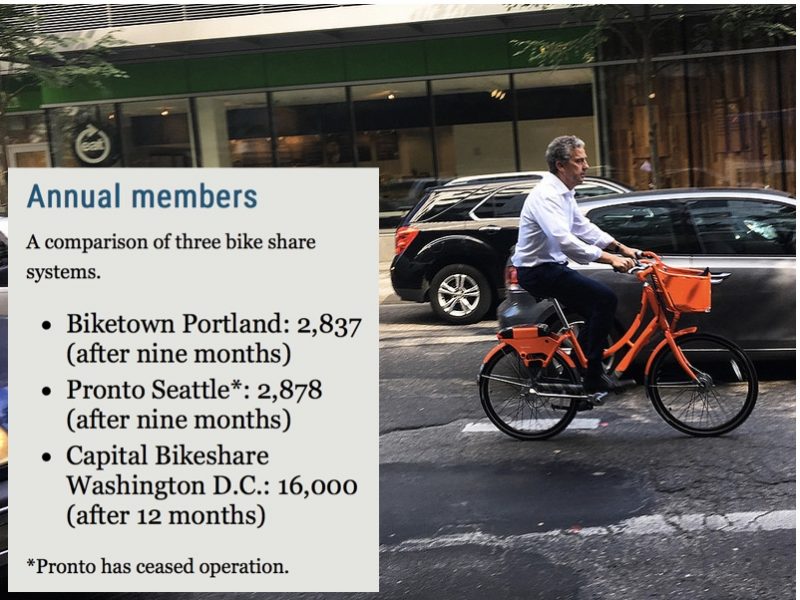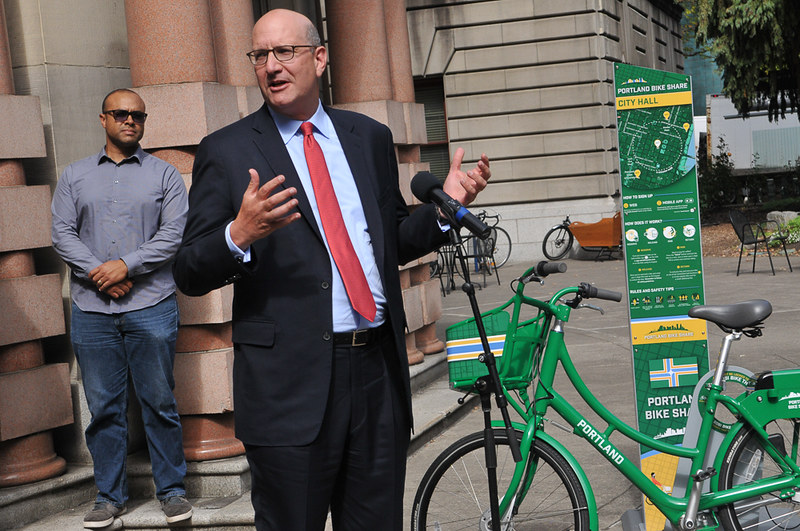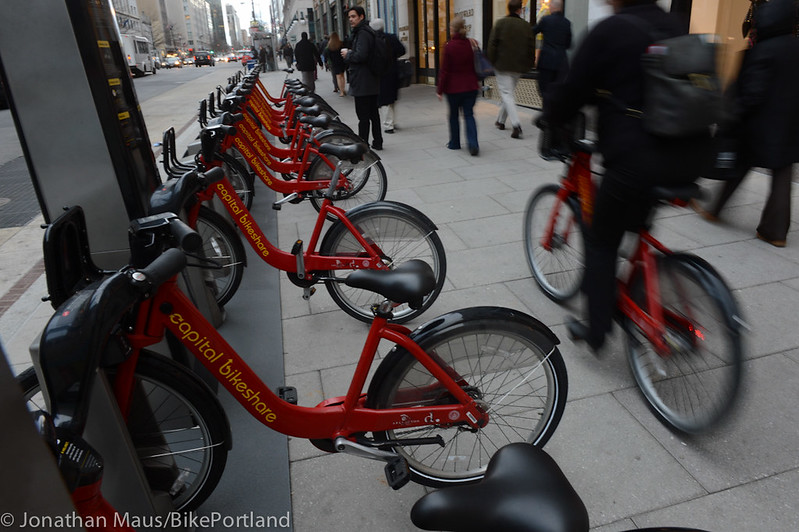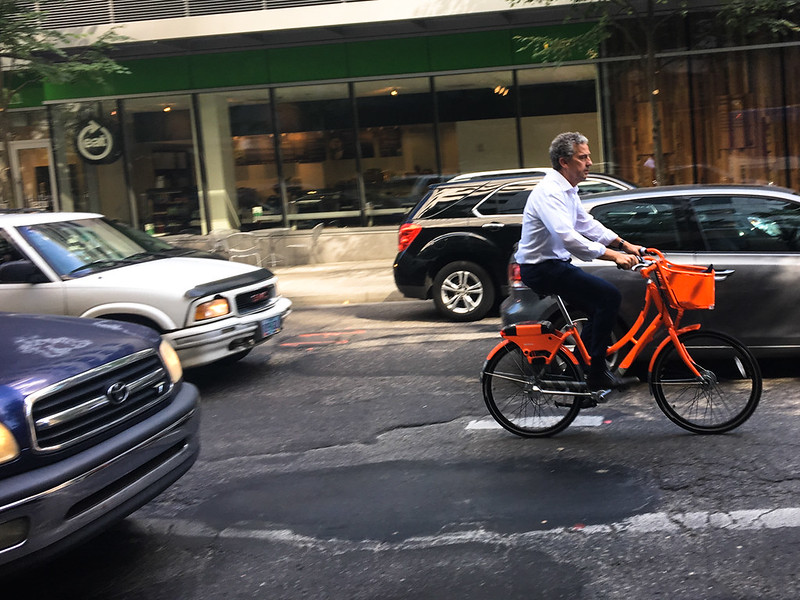
(All photos by Jonathan Maus/BikePortland)
Portland’s bike sharing system could have a bumpy road ahead even if political vandals decide to leave it be.
Biketown launched nine months ago next week with 1000 bikes and 100 stations. Thanks to title sponsorship from Nike, it was one of the country’s largest bike-share launches — double the station and bike count of Seattle’s Pronto system when it launched in 2014.
Pronto, which like Biketown was operated by New York-based Motivate Inc., turned into the country’s highest-profile bike-share failure to date. Plagued by low ridership and a series of financial missteps and miscommunications, it shut down at the end of last month.
And though Portland’s Biketown is a very different system with a different price structure, its annual membership numbers for year one are on a very similar trajectory to Pronto’s.
In Pronto’s month nine, June 2015, that system had 2,878 annual members. As of Monday, the city says, Biketown has 2,837.
Washington D.C.’s Capital Bikeshare, by contrast, had almost 16,000 annual members by the end of its first year, in 2010.
But it’s not time for Biketown’s fans to panic. Though the system faces challenges and definitely couldn’t be described as a roaring success, it also has an unusual amount of time to pick up its growth pace — and some clear steps that might help it do so.
Biketown’s private operator will underwrite any losses through 2019
Biketown arrived last year at an important time for Motivate, its private operator. That may be proving lucky for Portland.
The company had first existed as the then-Portland-based Alta Bicycle Share, founded and bootstrap-financed by the owners of the respected consulting firm Alta Planning + Design. Those early years could be described either as catastrophic success or gradually mounting chaos. Almost too big to fail because of its huge contracts in New York, D.C. and Chicago, Alta Bicycle Share escaped a complicated set of problems by selling itself to a New York-based joint venture, which rebranded the company as Motivate and hired internationally celebrated mass transit executive Jay Walder as CEO.
Meanwhile, bike sharing technology had advanced quickly, threatening to leave Motivate in the dust. “Smart bike” systems with free-floating bikes and on-board computers were spreading rapidly; all of Motivate’s launches had relied on more finicky “smart dock” hardware. So it was in Motivate’s interest to prove that it could score a high-profile launch and operate a system on newer technology.
Motivate sealed the Portland smart-bike contract by guaranteeing to cover any of the system’s losses for its first three years, through July 2019. (If there are surpluses in that period, the company gets to pocket half of those.) That’s not as long as Biketown needs to exist; its initial $10 million Nike contract runs for five years. But it’s much longer than Pronto had. And it creates a backer with relatively deep pockets; cash flow was a major factor in Pronto’s collapse.
All that means that if Biketown needs to try some experiments to move its revenue or profits up, it has two more years to do so.
Annual members aren’t the most important metric of bikesharing success
The number of annual memberships isn’t everything. For one thing, each Biketown membership is unusually valuable.
“Long story short: If you compare Portland to similar cities, we’re doing just fine.”
— John Brady, PBOT
Capital Bikeshare’s first-year annual memberships sold for $75 per year and allowed unlimited “free” trips of 30 minutes or less. Pronto’s sold for $85. Biketown annual memberships cost more: they bill $12 monthly for an annual commitment of $144, and allow 90 minutes of “free” ride time per day.
And though annual members are essential to a sustainable system (in part because they’re its core political support), short-term bike sharing memberships are usually more profitable. And what really matters for the long term is how often people are finding the system useful: average trips per bike per day.
Portland Bureau of Transportation Spokesman John Brady said in an email Monday that Biketown’s launch year was line with its peers.
“We usually look to Denver and Minneapolis because they are roughly similar in size and density,” he said. “If you compare Portland to Denver and Minneapolis in the years that they opened (that is, not a full year), Portland’s 1 trip/bike/day stacks up nicely. Denver’s utilization was 0.9 trips/bike/day while Minneapolis’ was 1.1.”
“Long story short: If you compare Portland to similar cities, we’re doing just fine,” Brady wrote.
Those figures from the year of launch don’t include Portland’s unusually harsh winter of 2017. Counting the first quarter of this year, Biketown has averaged more like 0.7 rides per bike per day since its July launch — barely ahead of the 0.6 rides per bike per day (year-round) that eventually doomed Seattle’s Pronto.
In other words: if Biketown is going to continue to do just fine compared to the modestly successful systems in Denver and Minneapolis, it’ll need usage to pick up sharply again this summer.
Advertisement
Biketown’s biggest challenge is the environment it’s serving
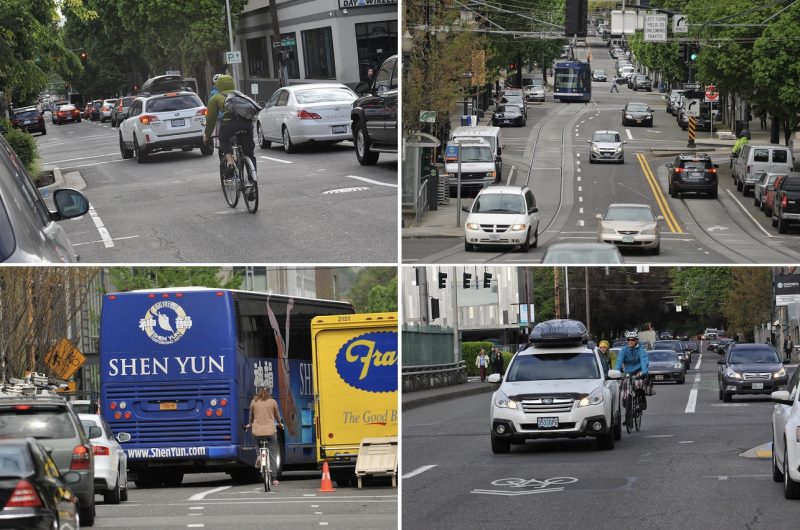
Here is the central dilemma for bike sharing in Portland: in a city without that much transit commuting or tourism, who is the customer base?
Biketown has decided, logically enough, to put a big bet on “people who live in the service area.” But because of how Portland is built, that’s not a huge number — about 86,000, to be specific.
Many of us would love to have a Biketown station three blocks from our place. We’d probably like a hardware store, a post office and a cute independent cafe there, too. But just as most of Portland simply isn’t dense enough to support those amenities within walking distance, most of it isn’t dense enough to support a bicycle transit system that’s operating with a direct public subsidy of $0.
That’s why Biketown’s stations have been most concentrated in the part of town that has true urban density: the Pearl District and the Northwest 20s. In Northwest, bike-share station density is one of the best in the country: almost every resident has a station less than three blocks away.
Some people complain, mistakenly, that focusing on Northwest Portland keeps Biketown out reach for all but the rich. But it’s a myth that Northwest Portlanders are homogenously well-off. The area has far more price-controlled housing, for both the poor and middle-income, than north Portland’s huge New Columbia development.
Instead, the problem with Northwest Portland is that it’s the close-in neighborhood with the worst bike infrastructure.
The perfect Biketown trip — in software terms, its killer app — would be a commute between a Northwest Portland apartment building (many of which offer terrible on-site bike parking) and a job in downtown Portland or the Central Eastside. But to make that trip, you have to cross Interstate 405 at an intersection like this:

And there’s no great route from Northwest to the Morrison Bridge, which ought to be the biking thoroughfare that feeds the Central Eastside.
Much of this is supposed to change soon. Northwest Portland’s hodgepodge of neighborhood greenways are up for improvement. The 19th/Alder/Burnside intersection is getting big improvements, and the long-delayed Central City Multimodal Safety Project might (or might not) give downtown a connected network of low-stress protected bike lanes, which Washington D.C. (for example) has been building but Seattle has so far failed to link up.
For Northwest Portland in particular, the crucial infrastructure improvement will be the planned Flanders Neighborhood Greenway and Flanders Crossing bridge across I-405, approved last year and scheduled (at the time, at least) to open in May 2019. That’ll be two months before Motivate stops backstopping Biketown against any losses.
There are a lot of experiments left to try
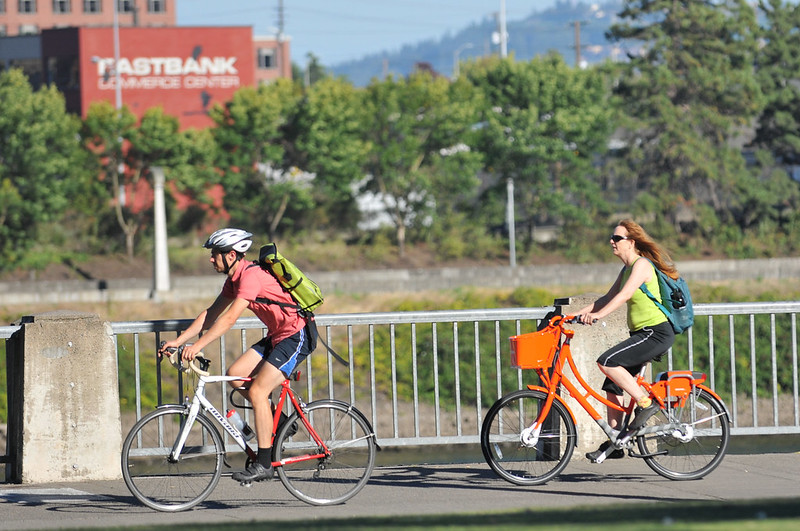
If things go seriously wrong in the next two years and Biketown fails, people might point to its unconventional lack of tightly regulated performance standards. They might point to Portland’s unusual decision to give the system no direct operating subsidy. They might point out that an uncommonly large 29 percent of Portland metro area adults already own a bike.
All of those factors could contribute to a failure, if things do go wrong. But each could also lay the groundwork for a system that, through a series of entrepreneurial innovations, sets the system up to gradually become one of the most successful in the country.
My own pet belief is that bike sharing will take off in the first U.S. city that offers it in a free or cheap bundle with a transit pass. A few people I talked to on the Internet yesterday had similar thoughts:
Imagine if you got a free 30 min ride with every trimet fare? I'd be riding orange bikes all the time.
— Steve 911 (@Intersection911) April 10, 2017
@BikePortland @andersem @PBOTinfo Would better transit integration help too (I.e. Hop? Maybe some cost Share?) 2.50 + 2.50 is a bit much for a one way trip
— Robert Getch (@StumpToEmerald) April 10, 2017
@andersem @Intersection911 this makes things more complicated, but an option for a $6 day pass, w/ $1 going to biketown, good for 30 min, could work
— Reed Andrews (@ReedKATU) April 10, 2017
As Robert Getch notes, later this year TriMet will launch the Hop Fastpass, a tap-and-go electronic fare card that could make this bundle theoretically possible. But getting it in place by 2019 seems difficult.
Whatever happens, I know that my homeward bike commute Monday was the nicest I’ve had this year. Summer is coming. We’re all about to find out what that means for Portland’s newest bicycling experiment.
— Michael Andersen, (503) 333-7824 – michael@portlandafoot.org
BikePortland is supported by the community (that means you!). Please become a subscriber or make a donation today.
